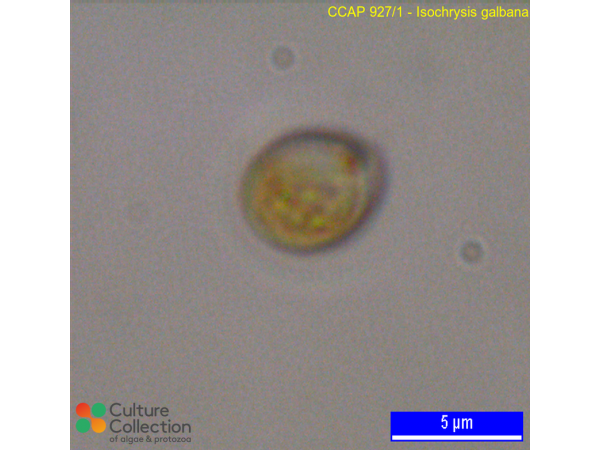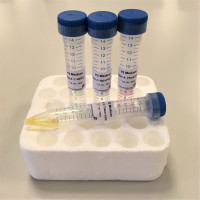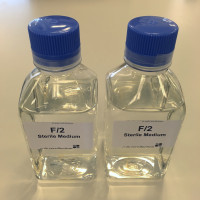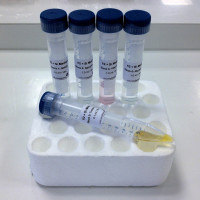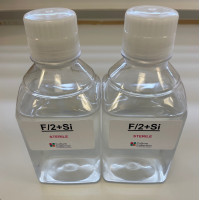References [ 48 ]
Qi B, Beaudoin F, Fraser T, Stobart AK, Napier JA & Lazarus CM (2002) Identification of a cDNA encoding a novel C18-Δ9 polyunsaturated fatty acid-specific elongating activity from the docosahexaenoic acid (DHA)-producing microalga, Isochrysis galbana. FEBS Letters 510: 159-165.
Cook KB, Bunker A, Hay S, Hirst AG & Spiers DC (2007) Naupliar development times and survival of the copepods Calanus helgolandicus and Calanus finmarchicus in relation to food and temperature. Journal of Plankton Research 29: 757-767.
Invidia M, Sei S & Gorbi G (2004) Survival of the copepod Acartia tonsa following egg exposure to near anoxia and to sulfide at different pH values. Marine Ecology - Progress Series 276: 187-196.
Halldórsson HP, Svavarsson J & Granmo A (2005) The effect of pollution on scope for growth of the mussel (Mytilus edulis L.) in Iceland. Marine Environmental Research 59: 47-64.
Sayegh FAQ, Radi N & Montagnes DJS (2007) Do strain differences in microalgae alter their relative quality as a food for the rotifer Brachionus plicatilis? Aquaculture 273: 665-678.
Zapata M & Garrido JL (1997) Occurrence of phyiwated chlorophyll c in Isochrysis galbana and Isochrysis sp. (Clone T-ISO) (Prymnesiophyceae). Journal of Phycology 33(2): 209-214.
Day JG, Benson EE & Fleck RA (1999) In Vitro Culture and Conservation Of Microalgae: Applications For Environmental Research, Aquaculture & Biotechnology. In Vitro Cellular & Developmental Biology - Plant 35: 127-136.
Martel CM (2009) Nitrogen-deficient microalgae are rich in cell-surface mannose: Potential implications for prey biorecognition by phagotrophic protozoa. Brazilian Journal of Microbiology 40: 86-89.
DOI: none
Devos M, Poisson L, Ergan F & Pencreac'h G (2006) Enzymatic hydrolysis of phospholipids from Isochrysis galbana for docosahexaenoic acid enrichment. Enzyme and Microbial Technology 39: 548-554.
Hatton AD & Wilson ST (2007) Particulate dimethylsulphoxide and dimethylsulphoniopropionate in phytoplankton cultures and Scottish coastal waters. Aquatic Sciences - Research Across Boundaries 69: 330-340.
Williams TD & Jones MB (1999) Effects of temperature and food quantity on the reproduction of Tisbe battagliai (Copepoda: Harpacticoida). Journal of Experimental Marine Biology and Ecology 236: 273-290.
DOI: none
Nyström B, Björnsäter B & Blanck H (1999) Effects of sulfonylurea herbicides on non-target aquatic micro-organisms. Growth inhibition of micro-algae and short-term inhibition of adenine and thymidine incorporation in periphyton communities. Aquatic Toxicology 47: 9-22.
DOI: none
Williams TD & Jones MB (1994) Effects of temperature and food quantity on postembryonic development of Tisbe battagliai (Copepoda: Harpacticoida). Journal of Experimental Marine Biology and Ecology 183: 283-298.
DOI: none
Clark DR, Merrett MJ & Flynn KJ (1999) Utilization of dissolved inorganic carbon (DIC) and the response of the marine flagellate Isochrysis galbana to carbon or nitrogen stress. New Phytologist 144: 463-470.
DOI: none
Davidson K, Flynn KJ & Cunningham A (1992) Non-steady state ammonium-limited growth of the marine phytoflagellate, Isochrysis galbana Parke. New Phytologist 122: 433-438.
DOI: none
Sayegh FAQ & Montagnes DJS (2011) Temperatures shifts induce intraspecific variation in microalgal production and biochemical composition. Bioresource Technology 102: 3007-3013.
Bale N, Airs RL & Llewellyn C (2011) Type I and Type II chlorophyll-a transformation products associated with algal senescence. Organic Geochemistry 42: 451-464.
Wilson ST (2007) The production of biogenic gases in the marine environment. A Thesis presented for the degree of Doctor of Philosophy at the Open University -: 319 pp.
DOI: none
Redfearn P (1987) Larval shell development of the northern tuatua, Paphies subtriangulata (Bivalvia, Mesodesmatidae) New Zealand Journal of Marine and Freshwater Research 21: 65-70.
Peperzak L & Brussaard CPD (2011) Flow cytometric applicability of fluorescent vitality probes on phytoplankton Journal of Phycology 47: 692-702.
Roleda MY, Slocombe SP, Leakey RJG, Day JG, Bell EM & Stanley MS (2013) Effects of temperature and nutrient regimes on biomass and lipid production by six oleaginous microalgae in batch culture employing a two-phase cultivation strategy. Bioresource Technology 129: 439-449.
Flynn KJ, Davidson K & Cunningham A (1996) Prey selection and rejection by a microflagellate; implications for the study and operation of microbial food webs. Journal of Experimental Marine Biology and Ecology 196: 357-372.
DOI: none
Sei S, Invidia M & Gorbi G (2006) Near anoxia and sulfide as possible factors influencing the spatial distribution of Acartia tonsa and Acartia clausi: Comparative evaluation of egg tolerance. Journal of Experimental Marine Biology and Ecology 337: 121-130.
Martel CM (2006) Prey location, recognition and ingestion by the phagotrophic marine dinoflagellate Oxyrrhis marina. Journal of Experimental Marine Biology and Ecology 335: 210-220.
Martel CM & Flynn KJ (2008) Morphological controls on cannibalism in a planktonic marine phagotroph. Protist 159: 41-51.
Zhang J, Wu C, Pellegrini D, Romano G, Esposito F, Ianora A & Buttino I (2013) Effects of different monoalgal diets on egg production, hatching success and apoptosis induction in a Mediterranean population of the calanoid copepod Acartia tonsa (Dana). Aquaculture 400-401: 65-72.
Ehara M, Watanabe KI, Kawai H, Inagaki Y, Hayashi-Ishimaru Y & Ohama T (1998) Distribution of the mitochondrial deviant genetic code AUA for methionine in heterokont algae. Journal of Phycology 34: 1005-1008.
DOI: none
Davidson K, Flynn KJ & Cunningham A (1991) Relationships between photopigments, cell carbon, cell nitrogen and growth rate for a marine nanoflagellate. Journal of Experimental Marine Biology and Ecology 153: 87-96.
DOI: none
Theroux S, Toney J, Amaral-Zettler L & Huang Y (2013) Production and temperature sensitivity of long chain alkenones in the cultured haptophyte Pseudoisochrysis paradoxa. Organic Geochemistry 62: 68-73.
Bendif EM, Probert I, Schroeder DC & de Vargas C (2013) On the description of Tisochrysis lutea gen. nov. sp. nov. and Isochrysis nuda sp. nov. in the Isochrysidales, and the transfer of Dicrateria to the Prymnesiales (Haptophyta) Journal of Applied Phycology 25: 1763-1776.
Cripps G, Lindeque P & Flynn KJ (2014) Have we been underestimating the effects of ocean acidification in zooplankton? Global Change Biology 20: 3377-3385.
Emami K, Hack E, Nelson A, Brain CM, Lyne FM, Mesbahi E, Day JG & Caldwell GS (2015) Proteomic-based biotyping reveals hidden diversity within a microalgae culture collection: An example using Dunaliella. Scientific Reports 5: 10036.
Day JG, Burt DJ, Achilles-Day UEM & Stanley MS (2013) Future algal biofuels: Implications of environmental temperature on production strain selection. International Journal of Ambient Energy 36: 248-252.
Slocombe SP, Zhang QY, Ross M, Anderson A, Thomas NJ, Lapresa A, Rad Menéndez C, Campbell CN, Black KD, Stanley MS & Day JG (2015) Unlocking nature's treasure-chest: Screening for oleaginous algae. Scientific Reports 5: 09844.
Cripps G, Lindeque P & Flynn K (2014) Parental exposure to elevated pCO2 influences the reproductive success of copepods. Journal of Plankton Research 36: 1165-1174.
Flynn KJ & Davidson K (1993) Predator-prey interactions between Isochrysis galbana and Oxyrrhis marina. II. Release of non-protein amines and faeces during predation of Isochrysis. Journal of Plankton Research 15: 893-905.
Flynn KJ & Davidson K (1993) Predator-prey interactions between Isochrysis galbana and Oxyrrhis marina. I. Changes in particulate δ 13C. Journal of Plankton Research 15: 455-463.
Cripps G, Flynn KJ & Lindeque PK (2016) Ocean acidifcation affects the phyto-zooplankton trophic transfer efficiency. PLoS ONE 11(4): e0151739.
Anderson SR & Menden-Deuer S (2016) Growth, grazing, and starvation survival in three heterotrophic dinoflagellate species. Journal of Eukaryotic Microbiology 64: 213-225.
Fouilland E, Galès A, Beaugelin I, Lanouguère E, Pringault O & Leboulanger C (2018) Influence of bacteria on the response of microalgae to contaminant mixtures Chemosphere 211: 449-455.
Sun Z, Wang X & Liu J (2019) Screening of Isochrysis strains for simultaneous production of docosahexaenoic acid and fucoxanthin Algal Research 41: 101545.
Fitzer SC, Plancq J, Floyd CJ, Kemp FM & Toney JL (2019) Increased pCO2 changes the lipid production in important aquacultural feedstock algae Isochrysis galbana, but not in Tetraselmis suecica Aquaculture and Fisheries 4: 142-148.
Laudicella VA, Beveridge C, Carboni S, Franco SC, Doherty MK, Long N, Mitchell E, Stanley MS, Whitfield PD & Hughes AD (2020) Lipidomics analysis of juveniles’ blue mussels (Mytilus edulis L. 1758), a key economic and ecological species PLoS ONE 15(2): e0223031.
Hughes AH, Magot F, Tawfike A, Rad-Menéndez C, Thomas N, Young LC, Stucchi L, Carettoni D, Stanley MS, Edrada-Ebel R & Duncan KR (2021) Exploring the chemical space of macro- and micro- algae using comparative metabolomics Microorganisms 9: 311.
Penhaul Smith JK, Beveridge C, Laudicella VA, Hughes AD, McEvoy L & Day JG (2021) Utilising mixotrophically cultured "designer algae" as blue mussel larval feed. Aquaculture International -: -.
Viegas C, Nobre C, Mota A, Vilarinho C, Gouveia L & Goncalves M (2021) A circular approach for landfill leachate treatment: Chemical precipitation with biomass ash followed by bioremediation through microalgae Journal of Environmental Chemical Engineering 9(3): 105187.
McLeod AR, Brand T, Campbell CN, Davidson K & Hatton A (2021) Ultraviolet radiation drives emission of climate-relevant gases from marine phytoplankton. Journal of Geophysical Research: Biogeosciences 126: 9.
Hughes AH, Magot F, Tawfike AF, Rad Menéndez C, Thomas N, Young LC, Stucchi L, Carettoni D, Stanley MS, Edrada-EBel R & Duncan KR (2021) Exploring the chemical space of macro- and micro-algae using comparative metabolomics. Microorganisms 9: 311.

